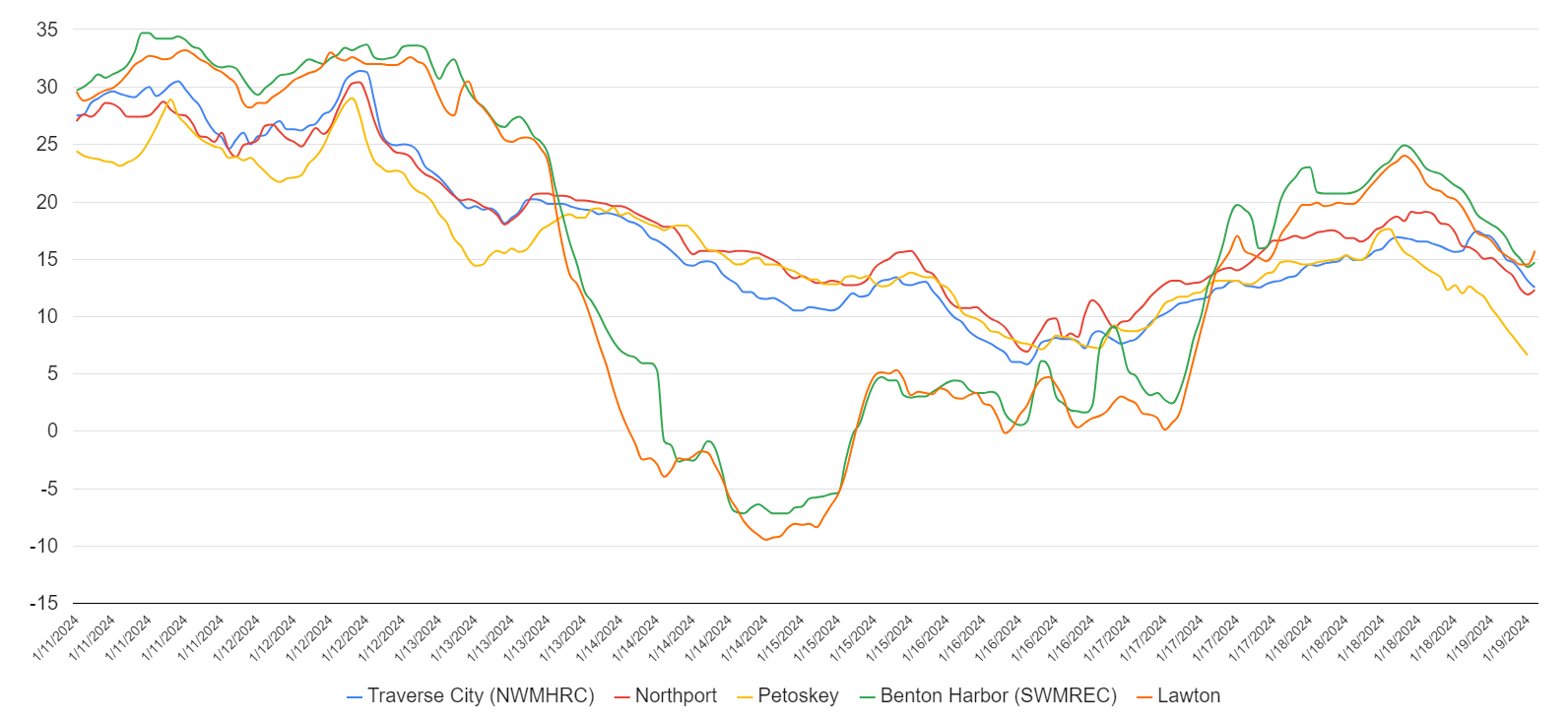Michigan's recent cold snap: Grapevine cold hardiness report
Michigan's recent cold snap caused potential cold damage in some regions. Growers are advised to delay pruning for a comprehensive assessment and strategic adjustments based on damage levels.

In cool and cold climate viticulture, one of the most significant challenges lies in minimizing cold damage and its impact on grapevine health and yield. This challenge encompasses not only bud mortality but also tissue health and ultimately, the overall production.
Cold hardiness plays a vital role in protecting dormant grapevine tissues during the harsh fall and winter months. It essentially determines their ability to withstand freezing temperatures and survive until spring. The key metric for cold hardiness is the lethal temperature 50 (LT50). This temperature signifies the point at which 50% of the primary buds are killed in midwinter, providing a crucial benchmark for assessing a grapevine's resilience to cold.
Our latest LT50 findings bring optimistic news for most Vinifera grapes in Leelanau, Grand Traverse, Benzie and Antrim counties, predicting minimal bud mortality in these regions.
However, the fluctuation and prolonged duration of cold temperatures (Figure 1) pose a risk of cold damage in southwest Michigan, particularly in vineyards situated farther from Lake Michigan's moderating influence. Growers in these areas are recommended to postpone pruning for as long as feasible during the dormant period. This delay should be utilized to thoroughly assess the scope of winter injury and subsequently modify pruning strategies based on the levels of bud and vine damage and mortality. Therefore, prior to initiating pruning, grape growers should meticulously evaluate each cultivar for potential bud damage. (Find more information in “Freezing stress, cold hardiness and managing winter damaged vines” from Michigan State University Extension.)
|
Table 1. Latest freezing tolerance assessment for common vinifera grape varieties in northwest Michigan. |
||
|---|---|---|
|
Variety |
LT50 (degrees Celsius) |
LT50 (degrees Fahrenheit) |
|
Riesling |
-20.5 |
-4.9 |
|
Merlot |
-18.8 |
-1.84 |
|
Cabernet Franc |
- 21.2 |
-6.16 |
|
Pinot noir |
-19.3 |
-2.74 |
|
Chardonnay |
-19.5 |
-3.1 |
Factors influencing cold hardiness:
- Temperature fluctuations: Gradual acclimation to cold is disrupted by warm spells, increasing vulnerability.
- Rapid temperature drop: Trunk splitting, triggered by sudden temperature drops, serves as a gateway for diseases like crown gall.
- Duration of low temperature: Affects trunk damage extent, especially in older trunks.
- Plant genetics: Vitis vinifera is sensitive, French hybrids hardier and native cultivars tougher (Table 2).
- Stress factors: Diseases, deficiencies, water issues and viruses reduce cold hardiness.
- Vine balance: Over/under-cropped vines are more susceptible; balanced vines resist better.
- Canopy management: Adequate sunlight exposure enhances wood maturation and cold hardiness.

To cope with winter injury in grapevines, a strategic approach involves delaying pruning during the dormant period. This delay allows for a thorough assessment of winter damage, enabling the adjustment of pruning strategies based on bud and vine damage levels. Grape growers should carefully evaluate each cultivar for bud damage before proceeding with pruning.
Understanding the bud morphology is crucial, with the primary bud carrying a significant portion of the cropping potential. Cross-sectional cuts through buds help identify their health status—green indicates vitality, while brown or black suggests mortality.
The number of buds assessed depends on the vineyard's damage. A sample of 40-50 buds is suitable, but for variable results, checking about 100 buds provides a more accurate damage level. After assessing bud damage, pruning strategies for the upcoming season should be adjusted accordingly.
|
Table 2. Relative cold hardiness of various grape genotypes. Adapted from Dami (2007), Freezing and Survival Mechanisms of Grapevines: Workshop Proceedings. |
|||
|---|---|---|---|
|
Cold hardiness class |
Range of critical temperatures |
Species |
Example of varieties |
|
Very tender |
5 to -5 F |
Most Vitis vinifera |
Chenin blanc, Merlot, Semillon, Syrah, Sauvignon blanc, Zinfandel |
|
Tender |
0 to -8 F |
Most Vitis vinifera |
Chardonnay, Cabernet-Sauvignon, Gewurztraminer, Pinot gris, Pinot noir, Sangiovese, Viognier |
|
Moderately tender |
-5 to -15 F |
Some Vitis vinifera and some hybrids |
White Riesling, Cabernet franc, Gamay noir, Chambourcin |
|
Moderately hardy |
-10 to -15 F |
Most hybrids |
Chardonel, Traminette, Norton, Vignoles |
|
Hardy |
-15 to -20 F |
Most Vitis labrusca |
Concord, Niagara |
|
Very hardy |
-20 to -30 F |
Some hybrids |
Frontenac, Foch |
Here are recommended pruning strategies based on varying levels of bud mortality, providing guidance for growers to optimize vine recovery:
|
Bud mortality |
Suggested strategy |
|---|---|
|
10-15% |
No adjustment needed. |
|
20-50% |
Leave more buds and prune to four to five bud spurs. |
|
60% |
Double the standard pruning strategy. |
|
More than 60% |
Minimal or no dormant pruning, focus on reestablishing the vine structure. |
When bud mortality exceeds 70%, the focus should shift towards reestablishing the fruit-bearing zone to ensure balanced vine growth during spring and summer. For severely damaged vines, expect new shoot growth from base buds, increasing shoots per vine and overall leaf area. Pruning efforts are essential for damaged cordons and trunks to reestablish the vine structure. In cases of severely injured trunks, considering replacement options is advisable. Strategically managing shoots, known as suckers, emerging from the base is crucial to contribute to leaf area recovery and guide growth towards the trellis system.
In conclusion, Michigan's recent cold snap poses challenges to grapevine cultivation in certain state regions. The latest LT50 results indicate favorable conditions for Vinifera grapes in specific counties, projecting minimal bud mortality. However, southwest Michigan confronts the potential risk of cold damage due to temperature fluctuations. To address this, growers are recommended to postpone pruning, allowing for a comprehensive assessment and strategic adjustments based on damage levels.



 Print
Print Email
Email